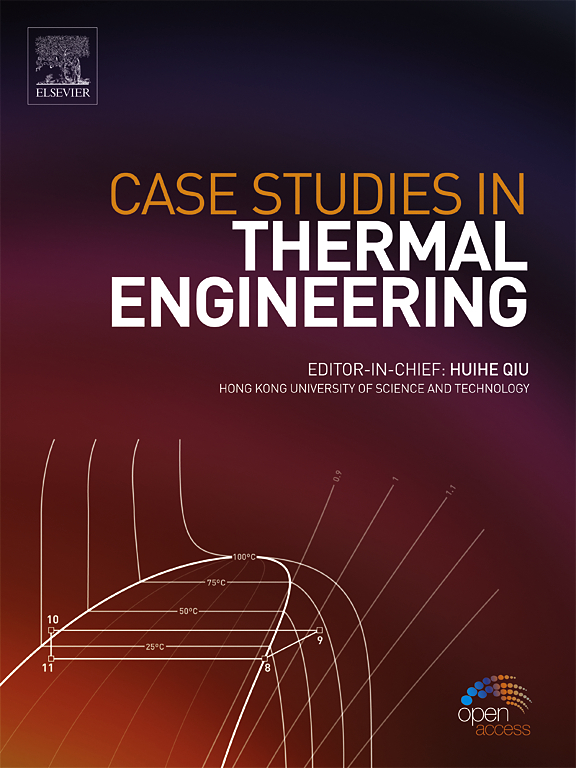基于发电和海水淡化应用的沼气燃气轮机循环 (GTC) 的高效热集成模型;基于热经济和 GA 的优化
IF 6.4
2区 工程技术
Q1 THERMODYNAMICS
引用次数: 0
摘要
随着全球能源需求的持续增长,迫切需要提高发电系统的效率和可持续性。本研究整合了改良型超临界二氧化碳(S-CO2)和多效脱盐(MED)装置,分两个阶段回收燃气轮机循环(GTC)中的余热,在减少 GTC 对环境影响的同时显著提高了发电量。这项研究的意义在于其综合方法,将热力学、环境和热经济分析与全面的敏感性评估相结合。利用 MATLAB 软件中的 NSGA-II 和 TOPSIS 决策方法,实施了三重优化框架来优化系统性能,重点关注放电效率、二氧化碳减排率和平准化能源成本等关键指标。通过净现值(NPV)分析,对经济可行性进行了评估,结果表明具有可观的盈利能力。最后,针对不同的可再生能源,对所设计系统的二氧化碳排放率进行了比较研究。所设计系统的一个具体应用是在发电 1441 千瓦的同时,还能产生 1.415 立方米/小时的蒸馏水。敏感性分析表明,燃烧室温度是最关键的设计参数,敏感性指数为 0.328。最佳经济指标明显改善,净现值从 237.1 万美元增至 1075 万美元,投资回收期从 13.28 年降至 7.18 年。本文章由计算机程序翻译,如有差异,请以英文原文为准。
Efficient thermal integration model based on a biogas-fired gas turbine cycle (GTC) for electricity and desalination applications; thermo-economic and GA-based optimization
As the global energy demand continues to rise, there is an urgent need to improve the efficiency and sustainability of power generation systems. This study integrated a modified supercritical carbon dioxide (S-CO2) and multi-effect desalination (MED) units to recover residual heat from a gas turbine cycle (GTC) in two stages, significantly enhancing electricity production while reducing the environmental footprint of the GTC. The significance of this study lies in its comprehensive approach, combining thermodynamic, environmental, and thermoeconomic analyses alongside thorough sensitivity evaluations. A triple optimization framework was implemented to optimize the system's performance, focusing on key metrics such as exergy efficiency, CO2 reduction rates, and levelized energy cost, utilizing the NSGA-II and the TOPSIS decision-making method in MATLAB software. Economic viability was assessed through a net present value (NPV) analysis, demonstrating substantial profitability. Finally, a comparison study of the devised system CO2 emissions rate was performed for different renewable energy sources. A specific application of the devised system is its capacity to generate 1.415 m³/h of distilled water while generating 1441 kW of electricity. Sensitivity analysis identified the combustion chamber temperature as the most critical design parameter, with a sensitivity index of 0.328. The optimum economic indicators showed marked improvement, with the NPV increasing from 2.371 M$ to 10.75 M$ and the payback period decreasing from 13.28 years to 7.18 years.
求助全文
通过发布文献求助,成功后即可免费获取论文全文。
去求助
来源期刊

Case Studies in Thermal Engineering
Chemical Engineering-Fluid Flow and Transfer Processes
CiteScore
8.60
自引率
11.80%
发文量
812
审稿时长
76 days
期刊介绍:
Case Studies in Thermal Engineering provides a forum for the rapid publication of short, structured Case Studies in Thermal Engineering and related Short Communications. It provides an essential compendium of case studies for researchers and practitioners in the field of thermal engineering and others who are interested in aspects of thermal engineering cases that could affect other engineering processes. The journal not only publishes new and novel case studies, but also provides a forum for the publication of high quality descriptions of classic thermal engineering problems. The scope of the journal includes case studies of thermal engineering problems in components, devices and systems using existing experimental and numerical techniques in the areas of mechanical, aerospace, chemical, medical, thermal management for electronics, heat exchangers, regeneration, solar thermal energy, thermal storage, building energy conservation, and power generation. Case studies of thermal problems in other areas will also be considered.
 求助内容:
求助内容: 应助结果提醒方式:
应助结果提醒方式:


